Bergaya F. Handbook of Clay Science
Подождите немного. Документ загружается.

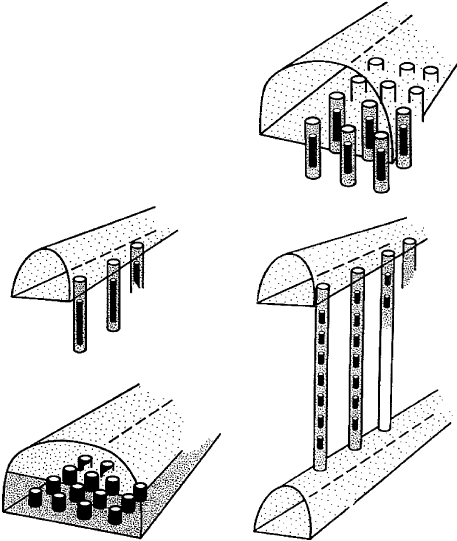
11.4.1. BUFFER MATERIALS
Table 11.4.1 shows the candidate buffer-clay materials tested in international
research work, and the major physical properties that have been determined. Typical
hydraulic conductivity and swellin g pressure data of tested buffer materials are
collected in Tables 11.4.2 and 11.4.3 for different bulk densities.
In a few cases, the raw bentonite is so uniform and rich in smectite that only
simple drying in the sun of the excavated material with subsequent grinding is
required at the quarries and plants. However, in most cases the clay material must be
dried in rotating kilns, and also transform ed to a suitable Na
+
-form.
The processed clay is commonly stored in silos or in stock piles protected from rain,
and is packed in 25–50 kg paper bags or 1000 kg big bags for delivery. The preparation
of buffer clay is made by compaction of dry clay powder to blocks with a high density.
The blocks are then placed in the deposition holes to surround the canisters as
illustrated in Fig. 11.4.3 for the Swedish KBS-3 concept. Fig. 11.4.4 shows a big ring-
shaped block of bentonite for use in a KBS-3 repository (Johannesson et al., 1995).
Fig. 11.4.1. Repository concepts, most of them implying that canisters with highly radioac-
tive waste are surrounded by dense smectite clay and placed in holes or tunnels.
Chapter 11.4: Clays and Nuclear Waste Management704

For isolation of less dangerous radioactive waste with a lifetime of less than about 500
years and causing almost no heat by radioactive decay, loosely filled granulates of
smectite clay can be used as shown in Fig. 11.4.2.
11.4.2. PREDICTED PERFORMANCE OF THE ‘‘CLAY BUFFER’’
There are three major phases in the performance of the engineered buffer barrier:
a first phase comprising application and evolution of the buffer including water
uptake and swelling, leading to maturation (0–100 years); a second phase with the
matured buffer exposed to a thermal gradient (100–1000 years); and a third phase
with tectonic or glacial impact under ambient or reduced temperature
(1000–1,000,000 years).
The first phase involves strong radiation and complex physico-chemical processes
partly controlling the long-term performance of the buffer. This phase was regarded
A
C
B
B
D
E
F
H
G
30 m
50 m
Fig. 11.4.2. Schematic section through a big concrete silo for final storage of low and in-
termediate radioactive waste in Sweden. (A) Cement-stabilised sand, (B) Concrete plugs, (C)
Top cover of bentonite/sand mixture, (D) Concrete silo, (E) Fill of granulated bentonite, (F)
Waste packages, (G) Bottom bed of bentonite/sand mixture (10/90) and (H) Rock drainage
with discharge to a lower tunnels system until the repository is closed.
11.4.2. Predicted Performance of the ‘‘Clay Buffer’’ 705

as particularly important and has therefore been the focus of most of the interna-
tional work up to now. If the hydraulic conductivity and swelling pressure are not
significantly changed during this phase, the buffer will be practically impermeable. As
such, it can serve as an excellent isolation of the waste in any time perspective. This
applies if the canisters stay intact for the first few thousands of years, and significant
mineral changes in the buffer do not occur in any of the phases. It is therefore
of fundamental importance that the canister-embedding clay offers physical and
Table 11.4.1. Physical properties of some buffer clay candidates. The first column indicates
the major smectite mineral (Mt. means Montmorillonite) and the name of the commercial
product
Clay Manufacturing company Smectite
content
Properties
1
KDp
s
l (f, a, b)
Mt. MX-80 American Colloid (USA) 75 * ****
Mt. Tixoton Su
¨
d-Chemie (Germany) 90 * — * — —
Mt. Moosburg Su
¨
d-Chemie (Germany) 65 * — * — *
Mt. IBECO Na Silver & Baryte (Greece) 80 * — * * *
Mt. IBECO Ca Silver & Baryte (Greece) 80 * — * * *
Saponite (Geohellas, Greece) 80 * — * — —
Beidellite (Through Enresa, Spain) 35 * — * — —
Kunigel Kunimine Ind., Japan 50 * — * — —
Montm. RMN Obrnice (Czech Republic) 90 * — * * —
Mixed-layer,
Friedland
DURTEC (Germany) 45 * — * — —
* ¼ tests performed
1
K ¼ Hydraulic conductivity, D ¼ Diffusivity, p
s
¼ Swelling pressure, l ¼ heat conductivity and capacity,
(f,a,b) ¼ rheological parameters.
Table 11.4.2. Hydraulic conductivity in m/s of SKB-tested potential buffer materials satu-
rated and percolated with distilled water. Bulk densities 1800–2100 kg/m
3
Density (kg/m
3
) 1800 1900 2000 2100
MX-80 4 10
13
210
13
810
14
310
14
IBECO, Na 9 10
13
—410
13
—
IBECO, Ca 2 10
11
—210
13
—
RMN — 4 10
13
—810
12a
Kunigel 3 10
12
—10
12
—
Beidellite 5 10
12
—510
13
—
Saponite 10
12
—510
13
—
a
With 5% graphite and 10% quartz powder.
Chapter 11.4: Clays and Nuclear Waste Management706
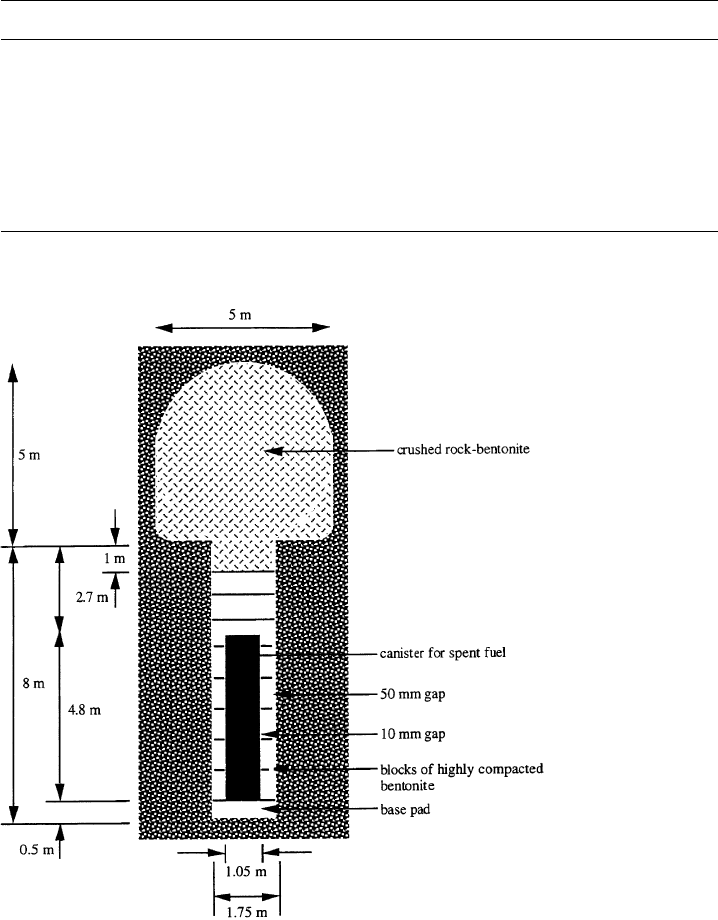
Fig. 11.4.3. Cross section of a deposition tunnel and hole for disposal of 20 ton canister of
copper and steel containing used reactor fuel rods. KBS-3 concept.
Table 11.4.3. Swelling pressure (p
s
) in MPa of a number of tested buffer materials saturated
with distilled water
Density at saturation (kg/m
3
) 1300 1500 1700 1800 1900 2000 2100
MX-80 0.06 0.2 0.4 0.8–0.9 1.4 4–5 10–12
IBECO, Na — — — 0.6–1 — 4–5 —
IBECO, Ca — — — 0.2 — 5 —
RMN — — 0.45 1.9
a
2.5
b
3.9
b
—
Beidellite — — — 1.5 — 4.2 —
Saponite — — — 2.5 — 8.8 —
Kunigel — — — 0.2 — 0.9 —
Friedland — — 0.05 0.1 0.3 0.8–1 2–2.5
a
Density at saturation 1850 kg/m
3
.
b
Mixture with 5% graphite and 10% quartz powder. Density at saturation 1950 kg/m
3
.
11.4.2. Predicted Performance of the ‘‘Clay Buffer’’ 707
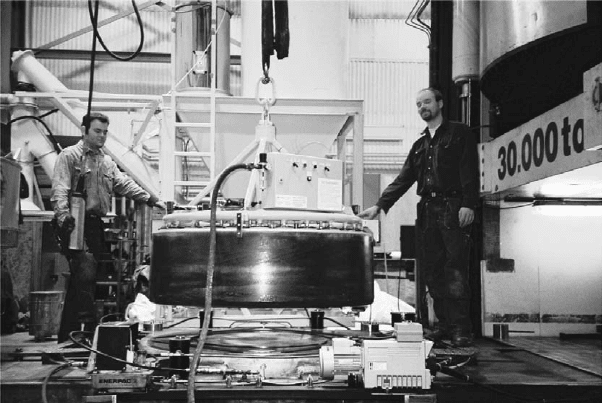
chemical environments that preserve the tightness of the canisters for a long time, and
delay the migration of radionuclides that may ultimately escape from them.
Taking the KBS-3 reporitory concept as a reference for isolation of highly
radioactive waste by the use of compacted smectitic blocks a generalised conceptual
model of the buffer has the following features:
1. Thermally induced redistribution of the initial pore-water in the clay
2. Uptake of water from the rock and backfill leading to hydration of the buffer
3. Expansion of the buffer yielding displacement of the canisters and overlying
backfill
4. Dissolution of buffer minerals and precipitation of chemical compounds in the
buffer.
Processes related to temperature are termed (T); those related to hydraulic proc-
esses (H); those dealing with mechanical, or rather rheological, behaviour (M); and
mechanisms that have to do with chemical changes are termed (C).
A. Thermally Induced Redistribution of the Initial Pore-Water and Maturation of the
Pellet Fill(TH)
Pore-water is transported in liquid and vapour form from the hotter to the colder
parts of the buffer. This yields early saturation of the buffer close to the rock and
desiccation close to the hot canister.
Fig. 11.4.4. Block of uniaxially compacted MX-80 clay powder using 100 MPa pressure. The
diameter is 1.7 m and the height 0.5 m. The water content is about 12% and the density
approximately 2000 kg/m
3
.
Chapter 11.4: Clays and Nuclear Waste Management708
B. Uptake of Water from the Rock (THMC)
Uptake of water from the rock and backfill is the process that ultimately yields
complete water saturation and the final density distribution. If the rock gives off very
little water to the clay, the backfill in the overlying tunnel may serve as the major
water source. The water transport from the backfill to the buffer is controlled by the
water pressure and by the suction of the buffer, as well as by the degree of water
saturation of the backfill.
The wetting has a (C)-effect since Ca
2+
,Mg
2+
,K
+
,SO
4
2
and Cl
ions will be
precipitated at the wetting front which moves towards the canister. Thus, a rather
large part of the buffer may contain such precipitates, which interact with the
smectite minerals and the canisters. The temperature gradien t has also a (C)-effect.
This is because silicate minerals (including the smectite component) that are close to
the heater will dissolve to a larger extent than those at the rock. The mechanism by
which released silica migrates towards the rock and precipitates in the outer part of
the bentonite is not well understood. Silicification causes some cementation and
brittleness of the clay.
11.4.3. NUMERICAL MODELLING
The evolution of a detailed design of the buffer (the interacting components for
the KBS-3 concept are defined in Fig. 11.4.5) has to be modelled with respect to
maturation and homogenisation. Current co-operative international work, partly
supported by the EU, deals with these issues. The conceptual model is the basis for
the selection and development of numerical tools to predict and evaluate the T, H, M
and C processes in the engineered barriers.
The proposed numerical formulations are exemplified by the EU-supported on-
going work ‘‘Prototype Repository Project’’ by H.R Thomas and P.J Cleall (per-
sonal communication) at Cardiff University. The main features of their numerical
model, code-named COMPASS, are
1. Moisture flow involves both liquid flow and vapour transfer. Liquid flow is as-
sumed to follow a generalised Darcy’s law, while vapour transfer is represented by
a modified Philip and de Vries approach.
2. Heat transfer includes conduction, convection and latent heat of vaporisation
transfer in the vapour phase.
3. Flow of dry air due to the bulk flow of air and that of dissolved air in the liquid
phase are considered. The bulk flow of air, induced by an air pressure gradient, is
again represented by a generalised Darcy’s law. Henry’s law is employed to cal-
culate the quantity of dissolved air and its flow is coupled to the flow of pore-liquid.
4. Deformation effects are included via either a non-linear elastic approach or an
elastoplastic formulation. In both cases de formation is taken to be dependent on
suction, stress and temperature changes.
11.4.3. Numerical Modelling 709
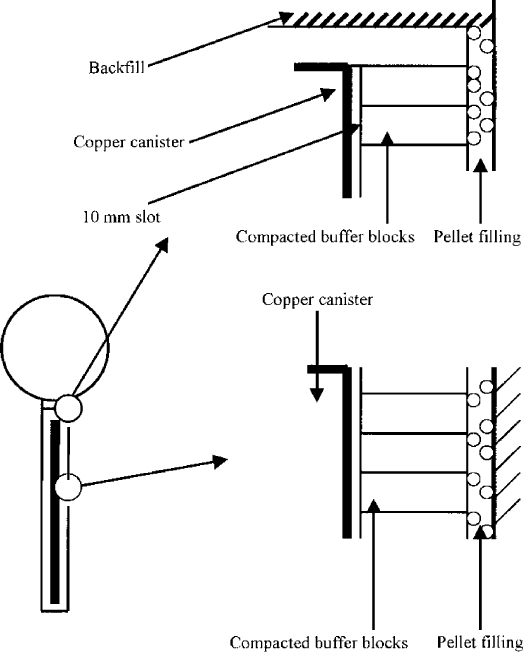
5. Chemical solute transport for multi-chemical species includes diffusion, dispersion
and accumulation from reactions due to sorpti on.
The basis for formulation of governing equations is that heat conduction and flow
are expressed using classical physics but is generalised by including the velocities of
liquid, vapour and air. The velocities of pore-liquid and pore-air are calculated using
a generalised Darcy’s law with special respect to the chemical solute concentration
gradient, the conductivity of the air phase and the pore-air pressure. Also, an
osmotic flow term in the liquid velocity is included to represent liquid flow behaviour
in some highly compacted clays. Air in partly saturated soil may exist in two forms:
bulk air and dissolved air. In this approach, the proportion of dry air in the pore-
liquid is defined using Henry’s law.
Fig. 11.4.5. Detail of KBS-3 deposition hole with copper-shielded canister embedded in
compacted buffer blocks and bentonite pellet filling.
Chapter 11.4: Clays and Nuclear Waste Management710
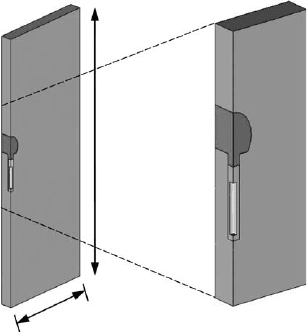
When a chemical solute is non-reactive, its sorption on to the soil surface may be
ignored. The governing equation for chemical transfer can then be expressed in terms
of diffusion and dispersion. This equation, given in primary variable form, can
be extended to a multi-chemical species form by introducing a sink term to account
for mass accumulation from reactions due to sorption. This is then coupled to a
geochemical model.
The total strain consists of components related to suction, temperature, chemical
and stress changes. Formulations have been employed, taking into account both
elasticity and elastoplasticity. The contribution of chemical solute to the stress-strain
behaviour of the soil can, to a first approximation, be described by an elastic state
surface concept based on osmotic potential.
A numerical solution of the governing differential equations is achieved by using
the Galerkin weighted residual method to formulate the finite element discretisation.
Shape functions are used to define approximation polynomials in the flow and stress/
strain equations. The outcome of predictive modelling for the evolut ion of the ‘‘nea r-
field’’ KBS-3 concept, made at Cardiff University, are shown in Figs. 11.4.6 (basic
geometry), 11.4.7 (pore-water pressure in the buffer in contact with the canister) and
11.4.8 (temperature at the canister/ buffer contact).
Both the theoretical model and the full-scale experiments actually show in-flow
from the host rock overwhelming the predicted drying close to the hot canister,
leading to eventual saturation (Fig. 11.4.7). The peak in temperature evolution
(Fig. 11.4.8) represents the state when the buffer is at its driest. This demonstrates
the effect of coupling between the hydraulic field and the temperature field, and that
57.8
25
3
Fig. 11.4.6. Tunnel and rock section used for the thermal analysis and enlarged view of cross-
section (ongoing modelling at Cardiff University for the EU-supported project ‘‘Prototype
Repository Project’’).
11.4.3. Numerical Modelling 711

0.5 10
7
024 810
0
-0.5 10
7
-1 10
7
-1.5 10
7
-2 10
7
-2.5 10
7
-3 10
7
135
Time (Years)
67 9
Pore Water Pressure (Pa)
Fig. 11.4.7. Pore-water pressure plot at the heater/buffer interface at mid-heater height (on-
going modelling at Cardiff University for the EU-supported project ‘‘Prototype Repository
Project’’).
0
10
20
30
40
50
60
70
80
90
100
05678910
Time (Years)
1234
Temperature (°C)
Fig. 11.4.8. Temperature plot at the heater/buffer interface at mid-height of the heater (on-
going modelling at Cardiff University for the EU-supported project ‘‘Prototype Repository
Project’’).
Chapter 11.4: Clays and Nuclear Waste Management712
relevant numerical predictions should be based on coupled (THMC) models when
possible.
11.4.4. LONG-TERM PHYSICAL PERFORMANCE OF THE BUFFER
For physical stability of the buffer clay two major factors are identified: colloid
transport and filtering, and microbiological filtering.
The issue of colloid transport through buffers was not examined in detail but
some general conditions were defined. For example, by sorbing pos itively charged
radionuclides and other cations, very small smectite particles can transport con-
taminants to the biosphere. Like many other constituents of colloidal size, such
particles can form aggregates, gels and networks that easily link to the dense buffer
clay (Pusch, 1999). Although smectite aggregates can be released if the pore-water
flow is sufficiently high, this seems impossible under the local hydraulic gradients
that prevail in the rock after closing the repository.
However, the buffer clay will tend to enter fractures in the rock although the front
of fracture-penetrating clay may be very soft. Groundwater flowing in the fractures
may, therefore, tear off small aggregates and transport them if the flow rate exceeds a
few millimeters per second. Experiments as well as field observat ions demonstrate
that the size of aggregates may range from 2 to 50 mm. Because of their surface
charge the aggregates can interact with, and attach to, the common fracture min-
erals, such as chlorite and micas. For this reason, the transport of smectite aggre-
gates over long distances is not significant.
Bacteria may stay alive and develop in soft smectitic clay. Those that reduce sulphate
are of particular importance to engineered barriers of the SKB-type as they usually
carry a negative surface charge, and hence can move through clay like large organic
polymers, such as humus colloids. However, such movement can be limited, at least
partly, by hydration conditions and the very small pore space that exists in dense buffer
clay (Pedersen, 1997). For MX-80 type clay with a density higher than 1800 kg/m
3
,the
small size of interconnected voids and the limited access to free water prevent bacteria
from moving and staying alive. Although spores may survive and be operative, the
working hypothesis is that ultimately all life forms in the buffer will be eradicated.
11.4.5. CHEMICAL STABILITY OF THE BUFFER
While gamma radiation has a small impact on the longevity of the buffer smectites
(Pusch, 1994), dissolution and conversion to non-expanding clay minerals is a threat.
The chemical integrity of smectites is determined by thermodynamically controlled
reactions. Thus, mineral stability and transformations depend on the prevailing
conditions of temperature and temperature gradient under which minerals and pore-
water interact.
11.4.4. Long-Term Physical Performance of the Buffer 713
